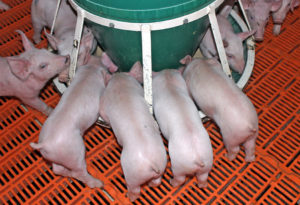In these days of rising input costs and the resulting razor-thin profit margins, the last thing a livestock farmer needs is a devastating disease outbreak. And because an outbreak is the last thing you need, a good biosecurity plan should be the first.
The effects of disease in a swine operation range from severe and rapidly spreading illness to a simple decrease in feed efficiency with little-to-no outward signs of infection. When profitability depends on scrutinizing every input and output of your operation, however, it doesn’t take a herd-culling outbreak to create problems for a producer.
There are two main components to every biosecurity plan: practices to prevent the introduction of disease (bioexclusion), and practices to control disease when it’s detected (biocontainment).
What to Watch For
All biosecurity plans start with a good understanding of the potential illnesses that can affect your herd and facilities.
Animal health experts and farmers alike keep an eye out for many diseases and pathogens, among them:
- Porcine proliferative enteropathy (ileitis)
- Porcine reproductive and respiratory syndrome (PRRS)
- Actinobacillus pleuropneumonia (APP)
- Porcine epidemic diarrhea (PED)
- Swine brucellosis
- Swine dysentery
- Streptococcus suis
- Glasser’s disease
- Swine influenza virus (SIV)
- African swine fever
Aside from watching for visible signs of disease, producers can identify illness by closely monitoring performance records. In hog breeding operations, a farmer may see changes in the average number of pigs weaned. After weaning, changing feed-to-gain ratios can indicate something’s off.
Modern livestock farming has the benefit of automated data-collecting equipment like Osborne’s Weight Watcher Growth Management System, to help producers keep track of behavioral data and pinpoint concerns.
Treating Disease
Management of disease is anything but one-size-fits-all. Farmers select and utilize the many tools at their disposal — pharmaceutical therapy, herd management, and more — based on a variety of factors. Farmers try to eradicate and guard against some diseases. For other diseases, either too mild or too difficult to prevent, farmers take a “maximize immunity/minimize the challenge” approach, balancing efforts to support their herd’s immunity and reduce the level of disease exposure in a manner that makes financial sense for their operation.
If you suspect a concerning disease among your pigs, you should take several steps immediately:
- Quarantine the animal(s) in question and any that carry a likelihood of exposure. Depending on the facility or practices involved, that area may consist of a single pen, a building, or even the entire farm.
- Obtain an official diagnosis from your veterinarian. This will determine the proper course of action.
- Treat the animals according to veterinarian recommendations and thoroughly complete prescribed facility sanitation requirements.
Disease Prevention Strategies
The financial, emotional, animal welfare, and public relations damage of disease outbreak can be devastating, so it’s no surprise farmers make avoiding one altogether a top priority. Ever heard the phrase “an ounce of prevention is worth a pound of cure”?
You’ll find solid strategies to keep both pig and producer healthy in our recent blog post, Best Practices for Swine Disease Prevention, which we’ve included here along with a few additional details:
- Create a biosecurity plan: Determine the right health management procedures (including vaccinations) for your farm, educate personnel and visitors, and identify the movement patterns of all people, animals, and other potential disease transporters on the farm.
- Safe herd management practices: When introducing new stock to an established herd, thoroughly vet the source and enact a quarantine period and testing protocol for a necessary additional layer of protection. Returning from the fair or livestock show? The same applies. Reduce the threat of outside contamination by erecting a perimeter fence.
- Careful observation: All stock should be monitored daily for illness or odd behavior. Keep a close eye on performance records. Note anything out of the ordinary and act quickly at the first sign that something is “off.”
 High-quality care: The connection between happy hogs and healthy hogs is clear. Osborne offers a full selection of farming supplies to assist you in this effort, including.
High-quality care: The connection between happy hogs and healthy hogs is clear. Osborne offers a full selection of farming supplies to assist you in this effort, including.
- Indoor and outdoor hog feeders that enhance efficiency and freshness
-
- ESF systems with RFID technology that allow for large pen gestation, minimizing stress
-
- Electric heat pads to promote healthy growth and reduce stress. More on heat pads.
- Facility hygiene. Osborne offers equipment that supports your efforts to keep facilities safe and clean.
- Feed bridging is more than an annoyance — it’s one of the most common reasons workers cite for exiting and re-entering a building, which carries contamination risks. Osborne’s Flow-Pro Bin Agitator eliminates the need for workers to manually dislodge bridged feed and ensures an uninterrupted first-in, first-out flow of even high-moisture feeds. We explore the topic further in our blog, Overcoming Bridging Issues in Bulk Feed Bins.
- Proper barn ventilation is vital to protect both animals and workers from harmful buildup of gases that can cause issues with animal performance and development. Osborne’s comprehensive selection of AGRI-AIDE ventilation products allows for optimal fresh air exchange. You have a lot of considerations to weigh when you’re designing the right mechanical ventilation system for your operation, which we tackled in this three-part Livestock Ventilation System Design Series.
Animal health experts acknowledge that prevention practices vary by disease, animal species, facility type, financial considerations, and other factors, but one piece of advice applies to all: Never let your guard down. Stay vigilant and remember that diseases are constantly changing. Your biosecurity plan will likely need adjustment periodically as well.



